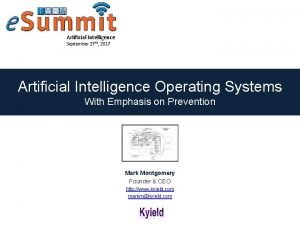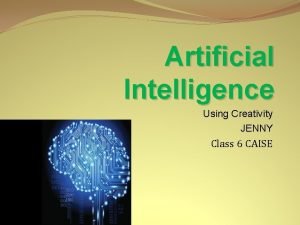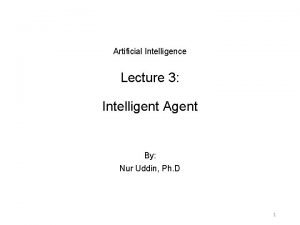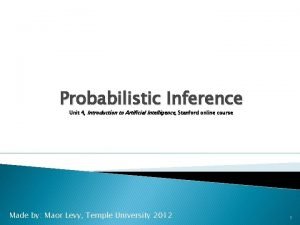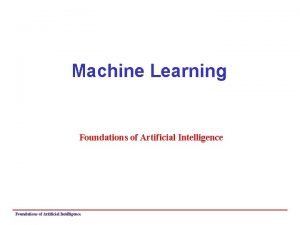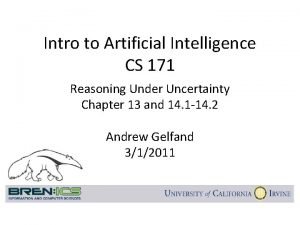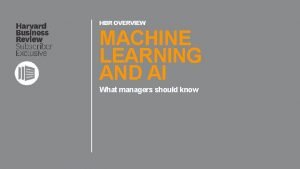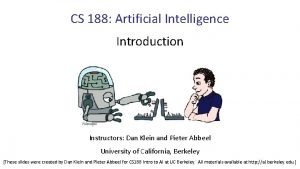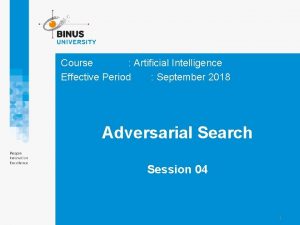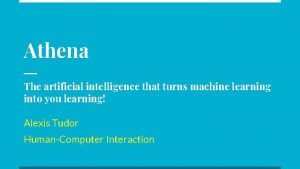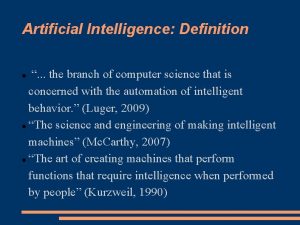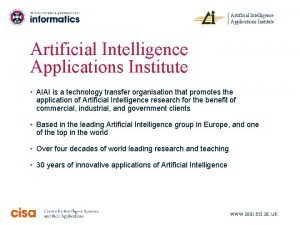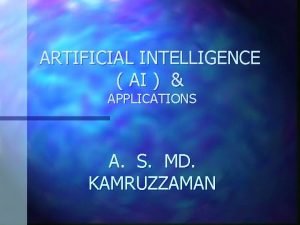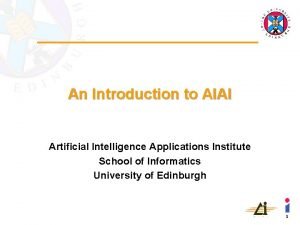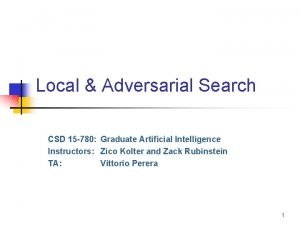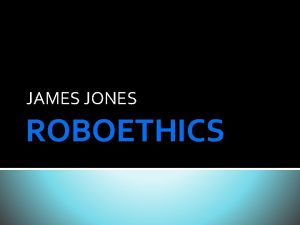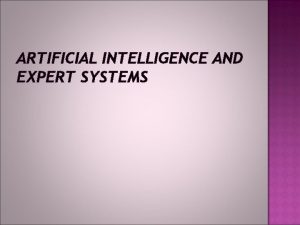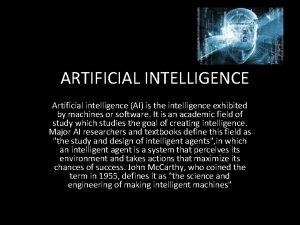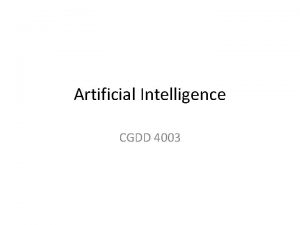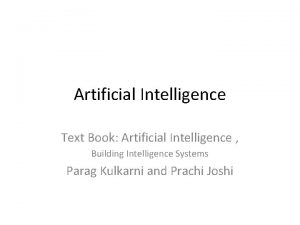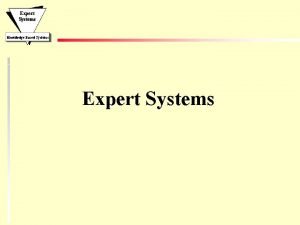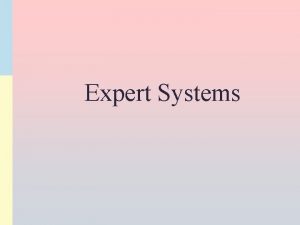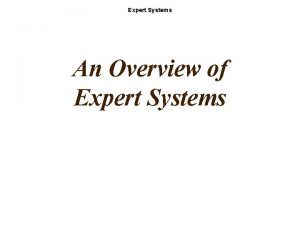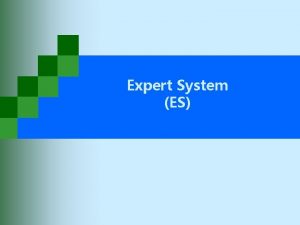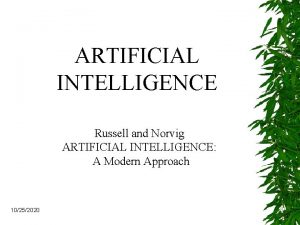Artificial Intelligence Expert Systems Expert System What is











































- Slides: 43

Artificial Intelligence Expert Systems

Expert System What is Expert System ? �An expert system, is an interactive computer-based decision tool that uses both facts and heuristics to solve difficult decision making problems, based on knowledge acquired from an expert. �An expert system is a model and associated procedure that exhibits, within a specific domain, a degree of expertise in problem solving that is comparable to that of a human expert.

�An expert system compared with traditional computer : Inference engine + Knowledge = Expert system ( Algorithm + Data structures = Program in traditional computer ) � First expert system, called DENDRAL, was developed in the early 70's at Stanford University. �It helps Organic Chemists in identifying unknown organic molecules, by analyzing their mass spectra and using knowledge of chemistry to produce a set of possible chemical structures.

1. Introduction �Expert systems are computer applications which embody some non-algorithmic expertise for solving certain types of problems. �For example, expert systems are used in diagnostic applications. �They also play chess, make financial planning decisions, configure computers, monitor and troubleshooting real time systems, and perform many services which previously required human expertise.

1. 1 Expert System Components And Human Interfaces �Expert systems have a number of major system components and interface with individuals who interact with the system in various roles.



1. 2 Expert System Characteristics Expert systems have many Characteristics : ■ Operates as an interactive system This means an expert system : ‡ Responds to questions ‡ Asks for clarifications ‡ Makes recommendations ‡ Aids the decision-making process.

■ Tools have ability to sift (filter) knowledge ‡ Storage and retrieval of knowledge ‡ Mechanisms to expand update knowledge base on a continuing basis. ■ Make logical inferences based on knowledge stored ‡ Simple reasoning mechanisms is used ‡ It must have means of exploiting ﺍﺳﺘﻐﻼﻝ the knowledge stored, else it is useless

■ Ability to Explain Reasoning ‡ Remembers logical chain of reasoning; therefore user may : ◊ ask for explanation of a recommendation ◊ ask for factors considered in recommendation ‡ these explanations Enhance the user confidence in recommendation and acceptance of expert system ■ Domain-Specific ‡ A particular system of a specific area; e. g. , a medical expert system cannot be used to find faults in an electrical circuit. ‡ Quality of advice offered by an expert system is dependent on the amount of knowledge stored.

■ Capability to assign Confidence Values ‡ Can deliver quantitative information ‡ Can address imprecise and incomplete data through assignment of confidence values. ‡ Can interpret qualitatively derived values ■ Applications ‡ Best suited for those dealing with expert heuristics for solving problems. ‡ Not a suitable choice for those problems that can be solved using purely numerical techniques.

■ Cost-Effective alternative to Human Expert ‡ Expert systems have become increasingly popular because of their specialization, even in a narrow field. ‡ Encoding and storing the domain-specific knowledge is economic process due to small size. ‡ Specialists in many areas are rare and the cost of consulting them is high; an expert system of those areas can be useful and cost-effective alternative in the long run.

1. 3 Expert System Features The features which commonly exist in expert systems are : ■ Goal Driven Reasoning or Backward Chaining An inference technique which uses IF-THEN rules to repetitively break a goal into smaller sub-goals which are easier to prove; ■ Coping with Uncertainty The ability of the system to reason with rules and data which are not precisely known; ■ Data Driven Reasoning or Forward Chaining An inference technique which uses IF-THEN rules to deduce a problem solution from initial data;

■ Data Representation The way in which the problem specific data in the system is stored and accessed; ■ User Interface That portion of the code which creates an easy to use system; ■ Explanations The ability of the system to explain the reasoning process that it used to reach a recommendation.

Uncertainty �Often the Knowledge is imperfect which causes uncertainty. �To work in the real world, Expert systems must be able to deal with uncertainty. �One simple way is to associate a numeric value with each piece of information in the system. �The numeric value represents the certainty with which the information is known. �There are different ways in which these numbers can be defined, and how they are combined during the inference process.

Data Representation �Expert system is built around a knowledge base module. �knowledge acquisition ﺍﻛﺘﺴﺎﺏ is transferring knowledge from human expert to computer. �Knowledge representation is faithful representation of what the expert knows. � No single knowledge representation system is optimal for all applications. � The success of expert system depends on choosing knowledge encoding scheme best suited for the kind of knowledge the system is based on. �The IF-THEN rules, Semantic networks, and Frames are the most commonly used representation schemes.

Explanations �An important features of expert systems is their ability to explain themselves. �Given that the system knows which rules were used during the inference process, the system can provide those rules to the user as means for explaining the results �By looking at explanations, the knowledge engineer can see how the system is behaving, and how the rules and data are interacting. � This is very valuable diagnostic tool during development

2. Knowledge Acquisition Knowledge acquisition includes the elicitation ﺍﺳﺘﺨﺮﺍﺝ , collection, analysis, modeling and validation of knowledge. 2. 1 Issues in Knowledge Acquisition The important issues in knowledge acquisition are: ■ knowledge is in the head of experts ■ Experts have vast amounts of knowledge ■ Experts have a lot of tacit knowledge ﻣﻌﺮﻓﺔ ﺿﻤﻨﻴﺔ ‡ They do not know all that they know and use ‡ Tacit knowledge is hard (impossible) to describe ■ Experts are very busy and valuable people ■ One expert does not know everything

3. Knowledge Base (Representing and Using Domain Knowledge) �Transferring knowledge from the human expert to a computer is often the most difficult part of building an expert system. �The knowledge acquired from the human expert must be encoded in such a way that it remains a faithful representation of what the expert knows, and it can be manipulated by a computer. � Three common methods of knowledge representation evolved over the years are: �IF-THEN rules �Semantic networks �Frames

3. 1 IF-THEN rules

3. 2 Semantic Networks �In this scheme, knowledge is represented in terms of objects and relationships between objects. � The objects are denoted as nodes of a graph. �The relationship between two objects are denoted as a link between the corresponding two nodes. � The most common form of semantic networks uses the links between nodes to represent IS-A and HAS relationships between objects.

Example of Semantic Network a car IS-A vehicle; a vehicle HAS wheels. �This kind of relationship establishes an inheritance hierarchy in the network

3. 3 Frames �In this technique, knowledge is decomposed into highly modular pieces called frames, which are generalized record structures. �Knowledge consist of concepts, attributes of concepts, relationships between concepts, and procedures to handle relationships as well as attribute values. ‡ Each concept may be represented as a separate frame. ‡ The attributes, the relationships between concepts, and the procedures are represented by slots in a frame. ‡ The contents of a slot may be of any data type - numbers, strings, functions or procedures and so on. ‡ The frames may be linked to other frames, providing the same kind of inheritance as that provided by a semantic network. � A frame-based representation is ideally suited for objectoriented programming techniques.

Example : Frame-based Representation of Knowledge. �Two frames, their slots and the slots filled with data type

4. Working Memory �Working memory refers to task-specific data for a problem �The contents of the working memory, changes with each problem situation. Consequently, it is the most dynamic component of an expert system. �Every problem in a domain has some unique data associated with it. �Data may consist of the set of conditions leading to the problem, its parameters and so on. �Data specific to the problem needs to be input by the user at the time of using, means consulting the expert system. �The Working memory is related to user interface.

�Fig. below shows how Working memory is closely related to user interface of the expert system.

5. Inference Engine �The inference engine is a generic control mechanism for navigating through and manipulating knowledge and deduce results in an organized manner. �The inference engine's generic control mechanism applies the axiomatic (self-evident) knowledge present in the knowledge base to the task-specific data to arrive at some conclusion. �Inference engine, the other key component of all expert systems.

�A knowledge base is usually very large, it is necessary to have inferencing mechanisms that search through the database and deduce results in an organized manner. �The Forward chaining, Backward chaining and Tree searches are some of the techniques used for drawing inferences from the knowledge base.

5. 1 Forward Chaining Algorithm �Forward chaining is a techniques for drawing inferences from Rule base. �Forward-chaining inference is often called data driven. � ‡ The algorithm proceeds from a given situation to a desired goal, adding new assertions (facts) found. � ‡ A forward-chaining, system compares data in the working memory against the conditions in the IF parts of the rules and determines which rule to fire.

5. 2 Backward Chaining Algorithm �Backward chaining is a techniques for drawing inferences from Rule base. �Backward-chaining inference is often called goal driven. ‡ The algorithm proceeds from desired goal, adding new assertions found. ‡ A backward-chaining, system looks for the action in the THEN clause of the rules that matches the specified goal.

5. 3 Tree Searches �Often a knowledge base is represented as a branching network or tree. �Many tree searching algorithms exists but two basic approaches are depth-first search and breadth-first search. ■ Depth-First Search ‡ Algorithm begins at initial node ‡ Check to see if the left-most below initial node (call node A) is a goal node. ‡ If not, include node A on a list of sub-goals outstanding. ‡ Then starts with node A and looks at the first node below it, and so on. ‡ If no more lower level nodes, and goal node not reached, then start from last node on outstanding list and follow next route of descent to the right.

�■ Breadth-First Search ‡ Algorithm starts by expanding all the nodes one level below the initial node. ‡ Expand all nodes till a solution is reached or the tree is completely expanded. ‡ Find the shortest path from initial assertion to a solution.

6. Expert System Shells �Many expert systems are built with products called expert system shells. �A shell is a piece of software which contains the user interface, a format for declarative knowledge in the knowledge base, and an inference engine. �The knowledge and system engineers uses these shells in making expert systems. �‡ Knowledge engineer : uses the shell to build a knowledge base for a particular problem domain. �‡ System engineer : builds the user interface, designs the declarative format of the knowledge base, and implements the inference engine.

6. 1 Shell components and description The generic components of a shell : �The knowledge acquisition, the knowledge Base, the reasoning, the explanation and the user interface. �The knowledge base and reasoning engine are the core components.

7. Explanation �Most expert systems have explanation facilities that allow the user to ask questions - why and how it reached some conclusion. �The questions are answered by referring to the system goals, the rules being used, and existing problem solving. �The rules typically reflect empirical, or "compiled“ knowledge. �They are codes of an expert's rules of thumb, not the expert's deeper understanding.


8. Application of Expert Systems �The Expert systems have found their way into most areas of knowledge work. �The applications of expert systems technology have widely spread to industrial and commercial problems, and even helping NASA to plan the maintenance of a space shuttle for its next flight. �The main applications are :

�Diagnosis and Troubleshooting of Devices and Systems: �Medical diagnosis was one of the first knowledge areas to which Expert system technology was applied in 1976. �However, the diagnosis of engineering systems quickly surpassed medical diagnosis. �Planning and Scheduling �The Expert system's commercial potential in planning and scheduling has been recognized as very large. �Examples are airlines scheduling their flights, personnel, and gates; the manufacturing process planning and job scheduling;

Configuration of Manufactured Objects from subassemblies: �Configuration problems are synthesized from a given set of elements related by a set of constraints. �The Expert systems have been very useful to find solutions. �For example, modular home building and manufacturing involving complex engineering design.

Financial Decision Making �The financial services are the vital user of expert system techniques. �Advisory programs have been created to assist bankers in determining whether to make loans to businesses and individuals. �Insurance companies to assess the risk presented by the customer and to determine a price for the insurance. �ES are used in typical applications in the financial markets / foreign exchange trading.

Knowledge Publishing �This is relatively new, but also potentially explosive area. �The primary function of the Expert system is to deliver knowledge that is relevant to the user's problem. �The two most widely known Expert systems are : �an advisor on appropriate grammatical usage in a text; �a tax advisor on tax strategy, tactics, and individual tax policy.

Process Monitoring and Control �Here Expert system does analysis of real-time data from physical devices, looking for anomalies, predicting trends, controlling optimality and failure correction. �Examples of real-time systems that actively monitor processes are found in the steel making and oil refining industries.

Design and Manufacturing �Here the Expert systems assist in the design of physical devices and processes, ranging from highlevel conceptual design of abstract entities all the way to factory floor configuration of manufacturing processes.
 Pxdes expert system
Pxdes expert system Dart expert system
Dart expert system Rule based deduction system in artificial intelligence
Rule based deduction system in artificial intelligence Artificial intelligence operating system
Artificial intelligence operating system What is state space search in ai
What is state space search in ai Searching for solutions in artificial intelligence
Searching for solutions in artificial intelligence 15-780 graduate artificial intelligence
15-780 graduate artificial intelligence Knowledge manipulation in ai
Knowledge manipulation in ai Types of knowledge
Types of knowledge Starts new page numbered sequentially
Starts new page numbered sequentially Artificial intelligence leadership
Artificial intelligence leadership Uas kecerdasan buatan
Uas kecerdasan buatan Math and artificial intelligence
Math and artificial intelligence Peas model ai
Peas model ai 15-780 graduate artificial intelligence
15-780 graduate artificial intelligence Xkcd image recognition
Xkcd image recognition Number of fuzzy propositions
Number of fuzzy propositions Cse 571 artificial intelligence
Cse 571 artificial intelligence 15-780 graduate artificial intelligence
15-780 graduate artificial intelligence Informed search and uninformed search in ai
Informed search and uninformed search in ai What is artificial intelligence class 6
What is artificial intelligence class 6 Levels of language analysis
Levels of language analysis Omniscience in artificial intelligence
Omniscience in artificial intelligence Int404
Int404 Artificial intelligence chapter 3
Artificial intelligence chapter 3 Partitioned semantic nets in artificial intelligence
Partitioned semantic nets in artificial intelligence A* vs ao* algorithm
A* vs ao* algorithm Artificial intelligence thesis proposals
Artificial intelligence thesis proposals Inference by enumeration in artificial intelligence
Inference by enumeration in artificial intelligence Learning in ai
Learning in ai Production rule for water jug problem
Production rule for water jug problem Optimal decisions in games in artificial intelligence
Optimal decisions in games in artificial intelligence Hbr artificial intelligence
Hbr artificial intelligence Cs 188
Cs 188 Optimal decisions in games in artificial intelligence
Optimal decisions in games in artificial intelligence Athena artificial intelligence
Athena artificial intelligence Using logic
Using logic Artificial intelligence is a branch of computer science
Artificial intelligence is a branch of computer science Artificial intelligence applications institute
Artificial intelligence applications institute Conclusion of artificial intelligence
Conclusion of artificial intelligence Artificial intelligence applications institute
Artificial intelligence applications institute Uninformed search methods
Uninformed search methods 15-780 graduate artificial intelligence
15-780 graduate artificial intelligence Ethics of artificial intelligence
Ethics of artificial intelligence



